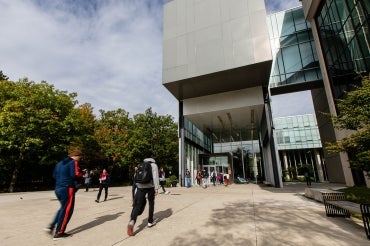U of T’s psychiatrist-in-chief on supporting students with mental health challenges

Published: October 24, 2019
Social pressures, academic deadlines, financial commitments, living away from home for the first time – these are just some of the challenges students navigate during university. And all of them can potentially contribute to pre-existing mental health issues.
Statistics show that the majority of Canadians are likely to be enrolled at a post-secondary institution by age 21 and that three quarters of mental health disorders are first diagnosed before the age of 25.

“These young people are studying and living in the post-secondary environment at an age that coincides with the peak age of onset of mental health and substance use issues,” says Andrea Levinson (left), psychiatrist-in-chief at U of T Health & Wellness and assistant professor of child and youth mental health in the department of psychiatry in the Faculty of Medicine.
“We also see a clear rise in the number of students seeking mental health services, as a result of increased awareness of mental health and decreased stigma.”
The trend, reported by colleges and universities across Canada, has prompted U of T to redouble efforts to expand mental health services. Earlier this year, President Meric Gertler announced a four-point action plan that included the creation of a task force to review student mental health supports.
There are also efforts underway to help the U of T community spot friends and colleagues who are experiencing mental health issues, which is key since heightened anxiety or depression can affect people’s ability to recognize their condition.
U of T News spoke with Levinson about the mental health challenges faced by university students and what is being done to support them.
What are the factors specific to university life that can exacerbate young people’s mental health struggles?
There’s the transition away from home, which provides all the wonderful things associated with university and college, but also brings about many life changes. New connections, social circles, friendships, support circles and so on all have to be navigated.
The academic stressors are a key transition issue, as are finances, in terms of managing the cost of education, and the financial burden that students carry through their degrees.
There’s also the role of technology in this age of social media – 24-7 connections and incessant inputs, and that means a lack of downtime.
In addition, there are health-care transitions occurring. The age of 18, while arbitrary, is often used as a cut-off for funding and the distinction between child and adult services. These transitional-aged youth or emerging adults are a very under-recognized and under-served population in general, and that happens to coincide with the age of arriving at post-secondary education.
What's behind the increase in students’ willingness to seek out mental health services on campus?
For one, there’s an overall increase in enrolment. In 2016, Statistics Canada showed that there were 1.79 million individuals enrolled in post-secondary education, up from one million in 2000, with the highest enrolment in Ontario and Quebec.
Watch Andrea Levinson answer questions on Facebook Live
Some are students who needed mental health care in their childhood or secondary school, but were unable to access it – and now that they’re coming to post-secondary, it’s an opportunity to seek help. Then there are students who did access mental health care and are now transitioning into post-secondary and expect ongoing support.
There’s also a reduced stigma and increased awareness of mental health and willingness to seek help, which is great and a success story.
There’s also data showing that youth have more of an increased perception of having a mental health problem, where they’re attributing their distress to a mental health issue and seeking professional help, rather than just perceiving it as stress or an academic issue.
What measures can students take in terms of habits and lifestyle choices to help them manage stress?
It depends a lot on the context and individual, but community-building is an overarching theme in self-care and stress management.
It’s important to make time for real-life social connections like hanging out with friends, socializing outside the classroom and connecting with peers through clubs and societies. Exercise, particularly exercise that involves social connections such as playing on a team or getting involved in intramurals, is very valuable, as are yoga, mindfulness and good nutrition.
Sleep is huge. It’s something that quickly gets minimized as a student, partly due to academic demands and deadlines. There are many drop-in workshops and sessions on sleep within the university support system.
In terms of academic stress, students can get support from the Academic Success Centre in terms of scheduling, balancing time and learning strategies and resources around managing timelines and deadlines.
It can also be very helpful to take part in community-minded things that take you beyond your own inner situation, whether it’s co-curricular activity or volunteering.
What steps can students, faculty and staff take if they have reason to be concerned about the mental health of a student or co-worker?
When one is feeling very low or anxious, and it’s impacting their functioning, this inherently impacts their ability to identify that there’s a problem and seek help. That’s why it’s so important to build community so that those closest to you can actually notice.
We have a 30-minute online training program being rolled out called Identify, Assist, Refer (IAR), which we encourage faculty members to subscribe to. It's a very helpful first step and revolves around the notion that we, as a community, need to be able to identify when someone is experiencing a mental health occurrence. There’s also IAR+, a tailored, in-person training program to assist groups on campus in applying the IAR skills to their specific context at U of T, using case studies, role play and other activities.
It can be based on general observations such as when someone seems to be behaving out of character on a persistent basis, they seem to be withdrawing, they may be sharing vague references to self-harm or suicide or they seem disconnected, helpless and hopeless.
In such a situation, it’s important to engage the person in a conversation and not necessarily advise them as a pseudo-therapist, but rather validate and acknowledge what they’re going through and instil hope. Then it’s about connecting them with the right resources and following up with them.
The onus can’t just be on the person who may be struggling. We all have a role to play as friends, peers, faculty and staff.
What are some recent measures taken by U of T Health & Wellness that you would like the university community to know about?
We are initiating same-day, single-session counselling for students. Additionally, we offer counseling support in the library during the exam period as well as expanded on-location counseling in various settings across campus to provide early intervention in a more proximal location. International students can access 24-7 support through My SSP, which offers text and chat services in multiple languages.
Within Health & Wellness, there’s an increased focus on inter-disciplinary care – utilizing the strengths of primary care physicians, nurses, mental health nurses, social work, psychology, psychiatry and others – as well as collaborative care and partnerships around mental health-care delivery.
Can you discuss the importance of university partnerships with community mental health providers, government and other external partners in addressing students’ mental health needs?
If we think about that statistic that more than 75 per cent of youth are engaging in post-secondary by age 21, it shows that the post-secondary environment is a young person’s functional world – and this is where the opportunity for prevention, identification and treatment of mental illness is ripe.
For many students, health-care providers on campus can help very effectively and efficiently with services such as on-location and walk-in counseling, workshops, mindfulness spaces and so on. But we also need to support very highly distressed students with more severe and persistent mental illness who are at higher risk of negative outcomes and need a higher level of care than a campus can provide.
Post-secondary clinics are typically not included in mental health-care reform efforts in Canada, and we’re left out of regional health planning efforts. It's also very difficult to find care in the community in a ready, timely way. Wait times in the community are very long, the barriers can be very high and the services, for the most part, are not particularly youth-friendly.
That’s why partnerships are needed. Campus is a great place to start, but we need seamless connections to various community services. There’s a great opportunity to expand links between campus mental health services and community and tertiary mental health and substance use programs, and that will enable us to accelerate evidence-based practices to support our students.
What impact can initiatives such as U of T’s Presidential and Provostial Task Force on Student Mental Health and consultations with the student body have?
The voice of students has to be embedded loud and clear in our efforts to evolve mental-health services. So the goal is to place students at the forefront by having them co-lead, co-develop and co-design the measures going forward.
The task force has done several consultations across the three campuses with lots of representation from students via focus groups – not to mention Accessibility Services, Student Life, crisis centres and other key stakeholders.
They’ve taken a very thorough approach, even holding consultations with external institutions. It’s a real scoping review of the current status of mental health services, which initiatives are flourishing, best practices and research of our own.
We anticipate a comprehensive approach and recommendations, some of which will not be quick or easy fixes to complex and multi-layered challenges. But it’s a really crucial step that will produce dynamic recommendations that will help take things forward.
Feeling distressed? Find someone to talk to right now – and if there is an immediate risk, call 911.
The following are some of the mental health services available to students on all three campuses:
Downtown Toronto: Health and Wellness Centre (416-978-8030), located at Koffler Student Services
U of T Scarborough: Health & Wellness Centre 416-287-7065.
U of T Mississauga: Health & Counselling Centre 905-828-5255
Round-the-clock support
Free 24/7 support is available outside the university. Students, staff and faculty can speak to a trained crisis worker at any hour of the day.
Good 2 Talk 1-866-925-5454
Gerstein Crisis Centre 416-929-5200.
Distress Centres of Greater Toronto 416-408-HELP (4357)
The Center for Addiction and Mental Health at 250 College Street
Anishnawbe Health Toronto Mental Health Crisis Line 416-360-0486
My SSP for International Students 1-844-451-9700. Immediate support is available in 35 languages and ongoing support in 146 languages
Appointed faculty and staff have access to the Employee & Family Assistance Program (EFAP), offered through Homewood Health, online and by phone at 1-800-663-1142.



